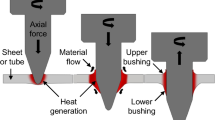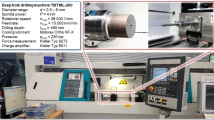Abstract
The cutting forces in drilling significantly affect the accuracy and quality of hole machining. The unbalanced radial component of the cutting force increases the hole diameter and decreases its accuracy. In machining composites, extreme axial cutting force separates the layers and impairs hole quality. Accordingly, there is a pressing need to predict the cutting forces in drilling. In the present work, the cutting force and torque in the drilling of 6061-T6 aluminum alloy are simulated by the smoothed particle Galerkin (SPG) method. Comparison shows that the results obtained are in good quantitative agreement with other calculations and experimental data.


Similar content being viewed by others
REFERENCES
Parsian, A., Magnevall, M., Beno, T., et al., A mechanistic approach to model cutting forces in drilling with indexable inserts, Procedia CIRP, 2014, vol. 24, pp. 74–79.
Hamade, R.F., Seif, C.Y., and Ismail, F., Extracting cutting force coefficients from drilling experiments, Int. J. Mach. Tools Manuf., 2006, vol. 46, pp. 387–396.
Giasin, K., Ayvar-Soberanis, S., French, T., and Phadnis, V., 3D finite element modelling of cutting forces in drilling fibre metal laminates and experimental hole quality analysis, Appl. Compos. Mater., 2017, vol. 24, pp. 113–137.
Matsumura, T. and Tamura, S., Cutting force model in drilling of multi-layered materials, Procedia CIRP, 2013, vol. 8, pp. 182–187.
Wang, M., Gao, L., and Zheng, Y., An examination of the fundamental mechanics of cutting force coefficients, Int. J. Mach. Tools Manuf., 2014, vol. 78, pp. 1–7.
Watson, A.R., Drilling model for cutting lip and chisel edge and comparison of experimental and predicted results. I. Initial cutting lip model, Int. J. Mach. Tool Des. Res., 1985, vol. 25, no. 4, pp. 347–365.
Marusich, T.D., Usui, S., and Stephenson, D.A., Finite element modeling of drilling processes with solid and indexable tooling in metals and stack-ups, Proc. 10th CIRP Int. Workshop on Modeling of Machining Operations, Reggio Calabria, 2007, pp. 51–58.
Merino-Pérez, J.L., Royer, R., Merson, E., et al., Influence of workpiece constituents and cutting speed on the cutting forces developed in the conventional drilling of CFRP composites, Compos. Struct., 2016, vol. 140, pp. 621–629.
Sreenivasulu, R. and Srinivasa Rao, C., Modeling, simulation and experimental validation of Burr size in drilling of aluminum 6061 alloy, Procedia Manuf., 2018, vol. 20, pp. 458–463.
Patra, K., Jha, A.K., Szalay, T., et al., Artificial neural network based tool condition monitoring in micro mechanical peck drilling using thrust force signals, Precis. Eng., 2017, vol. 48, pp. 279–291.
Uhlmann, E. and Richarz, S., Twisted deep hole drilling tools for hard machining, J. Manuf. Process., 2016, vol. 24, no. 1, pp. 225–230.
Mathew, N.T. and Vijayaraghavan, L., Modeling of temperature distribution in the work material during drilling under sustainable environment, J. Manuf. Process., 2018, vol. 36, pp. 309–318.
Sultan, A.Z., Sharif, S., and Kurniawan, D., Chip formation when drilling AISI 316L stainless steel using carbide twist drill, Procedia Manuf., 2015, vol. 2, pp. 224–229.
Beer, N., Özkaya, E., and Biermann, D., Drilling of Inconel 718 with geometry-modified twist drills, Procedia CIRP, 2014, vol. 24, pp. 49–55.
Sambhav, K., Tandon, P., and Dhande, S.G., Geometric modeling and validation of twist drills with a generic point profile, Appl. Math. Model., 2012, vol. 36, no. 6, pp. 2384–2403.
Abouridouane, M., Klocke, F., and Döbbeler, B., Characterization and modeling of the machinability of ferriticpearlitic steels in drilling operations, Procedia CIRP, 2017, vol. 58, pp. 79–84.
Abele, E. and Fujara, M., Simulation-based twist drill design and geometry optimization, CIRP Ann., 2010, vol. 59, no. 1, pp. 145–150.
Girinon, M., Valiorgue, F., Karaounic, H., and Feulvarch, E., 3D numerical simulation of drilling residual stresses, C. R. Mec., 2018, vol. 346, pp. 707–711.
Gaiche, V., Gaiche, Y.S., and Patil, J.P., Prediction of thrust force and torque in drilling of glass fiber reinforced plastic using mechanistic force model approach, Procedia CIRP, 2018, vol. 77, pp. 187–190.
Author information
Authors and Affiliations
Corresponding authors
Additional information
Translated by B. Gilbert
About this article
Cite this article
Boldyrev, I.S., Smetanin, S.D. & Topolov, D.Y. Chip Formation in Drilling. Russ. Engin. Res. 41, 1091–1093 (2021). https://doi.org/10.3103/S1068798X2111006X
Received:
Revised:
Accepted:
Published:
Issue Date:
DOI: https://doi.org/10.3103/S1068798X2111006X




